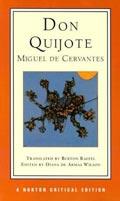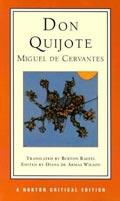
Publisher Comments
Don QuixoteThe text reprinted here is based on award-winning translator Burton Raffel'smasterful translation of Don Quijote, which is consistent, fluid, and modeled closely on the original Spanish.
Backgrounds and Context invites readers to explore the creative process that culminated in the publication of Don Quijote. Included are selections from works parodied by Cervantes (Amadis of Gaul and Orlando Furioso) and a portion of the spurious sequel to Part 1 written by Fernándes de Avellaneda.
Criticisms presents fifteen major interpretations of both the novel and selected episodes, describing Cervantes' intellectual milieu, revealing how he infused new life into the literary modes and motifs he had inherited, and illustrating the fundamental importance of Don Quijoteinthe history of modern fiction.
Synopsis
Part parody and part cautionary tale, "Don Quijote" is considered a literary masterpiece. This critical edition is based on Burton Raffel's translation that comes as close as possible to recreating Miguel de Cervantes'prose style - it is consitent, fluid and modelled on the original Spanish. Carefully selected background materials bring readers into the creative process that culminated in Don Quijote. Included is other writing by Cervantes as well as contemporary works by other authors and a modern account of the novel's influence throughout the ages. Fifteen critical essays present interpretations of both the novel and selected episodes.From Library Journal
A translator of Horace, Balzac, Rabelais, and Salvador Espriu, as well as a theorist (The Art of Translating Prose, Pennsylvania State Univ. Pr., 1994), Raffel (Univ. of Southwest Louisiana) undertook the formidable task of translating Cervantes's masterpiece because he was uncomfortable recommending any of the existing translations. There are some real differences here. Raffel has junked the traditional transcription of Cide Hamete, the pseudoauthor, in favor of the less "colonialist" and more authentic Arabic, Sidi Hamid. Proper names that contain puns are explained within square brackets, and footnotes are kept to a minimum. A more vernacular style reigns: The blow on the neck and the stroke on the shoulder that dub Don Quijote a knight are, respectively, a "whack" and a "tap." The women at the inn, usually called "wenches," are "party-girls" or "whores." Sancho dreams that his "old lady" will someday be a queen and that his "kids" will be princes. In the proofs, "Castile" has been misspelled as "Castille," an oversight one would hope to see corrected in the final book. This is a lively alternative to the wide assortment of truly old-fashioned translations.Book Dimension
Height (mm) 234 Width (mm) 142

